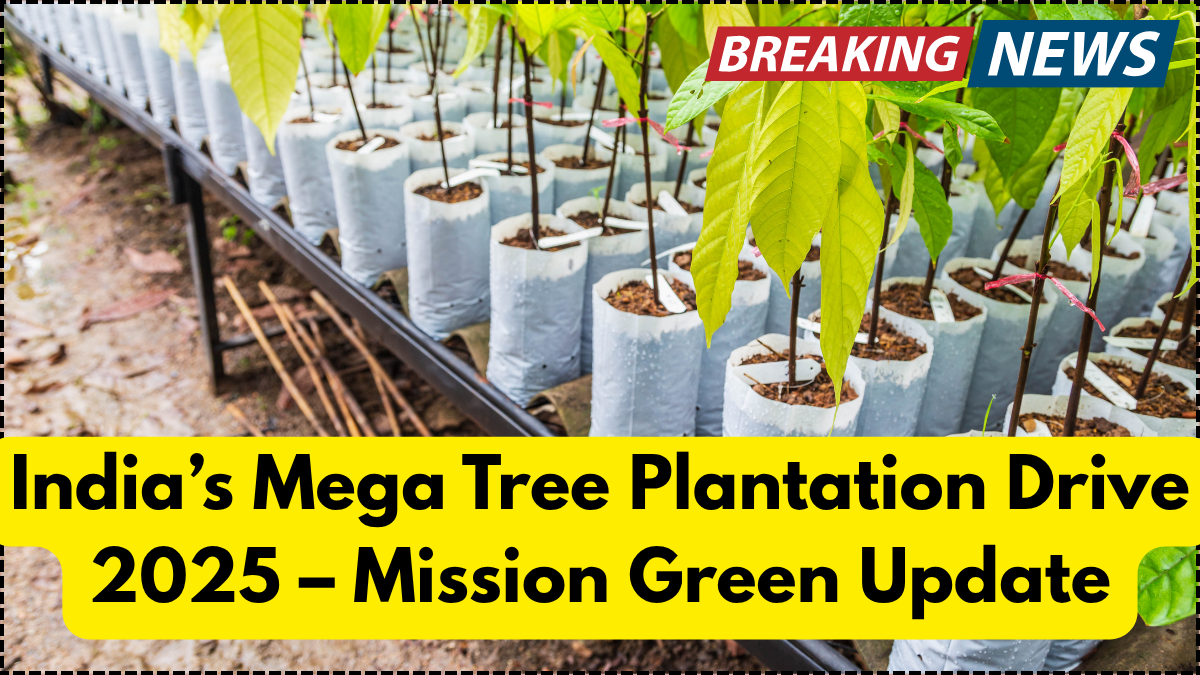July 2025 marks a significant chapter in India’s environmental mission with the launch of the most ambitious tree plantation initiative the country has ever seen. Dubbed “India’s Mega Tree Plantation Drive 2025,” this government-led campaign is pushing forward with aggressive targets to combat climate change, enhance forest coverage in India, and drive community-based green actions.

Why 2025 Is a Landmark Year for Forest Expansion in India
With global temperatures on the rise and extreme weather events becoming more frequent, India is responding with actionable change. The 2025 plantation drive isn’t just a ceremonial green event; it is a strategic operation to reforest degraded lands, buffer urban pollution, and restore critical wildlife corridors. According to the Ministry of Environment, Forest and Climate Change, the goal is to plant over 2.3 billion saplings by the end of September 2025.
The initiative is particularly focused on states with historically low forest coverage—including Rajasthan, Gujarat, and Uttar Pradesh. These states have rolled out aggressive afforestation programs in tandem with local NGOs and citizen volunteers. Satellite tracking and drone monitoring are being deployed to track survival rates and growth.
Environmental Mission with Grassroots Power
At the heart of this environmental mission is people power. From schoolchildren in Kerala planting native fruit trees to tribal communities in Madhya Pradesh restoring medicinal groves, the campaign reflects a deep social integration. More than 4 million citizens have already participated in plantation events organized since April.
In a departure from past efforts, this year’s drive emphasizes indigenous and climate-resilient species. Experts argue this approach improves long-term ecological stability and ensures the new green cover supports biodiversity. The campaign is also aligning with the United Nations Decade on Ecosystem Restoration, showcasing India’s commitment on the global stage.
Tracking Progress: India’s Green Mission by the Numbers
Below is a summary of key metrics from India’s Mega Tree Plantation Drive 2025 so far:
| Parameter | Value (As of July 2025) |
|---|---|
| Total Saplings Planted | 1.45 Billion |
| States Involved | 28 States & 8 Union Territories |
| Survival Rate (Initial Audit) | 78% |
| Forest Coverage Increase (Target) | +2.5% Nationally |
| Number of Citizen Volunteers | 4.2 Million |
Forest Coverage India: Bridging Gaps in the Green Map
Forest coverage in India stood at approximately 24.62% in 2023. The current plantation effort aims to elevate that to over 27% by the end of 2026, bridging regional gaps and restoring degraded ecosystems. Special attention is being paid to ecologically sensitive zones such as the Western Ghats and the Northeast hills.
Innovative tools are also being used to measure carbon sequestration potential and soil recovery rates in planted zones. Experts are optimistic that this drive will significantly offset urban carbon emissions while revitalizing groundwater levels through improved canopy density.
Conclusion: A Green Legacy in the Making
India’s Mega Tree Plantation Drive 2025 is more than a government campaign—it is a nationwide transformation. With real-time accountability, mass participation, and ecological science at the core, this initiative is laying the foundation for a sustainable future. If the current momentum continues, India could set a global benchmark for reforestation and environmental resilience.
FAQs on India’s Mega Tree Plantation Drive 2025
What is the target of India’s Mega Tree Plantation Drive 2025?
The target is to plant 2.3 billion saplings by the end of September 2025 across all Indian states and union territories.
How does this drive affect forest coverage in India?
The plantation drive is projected to increase forest coverage in India by at least 2.5% nationally, with focused efforts in states that have low green density.
Who can participate in this environmental mission?
Any citizen, school, college, NGO, or corporate group can participate through local campaigns, online registrations, or community plantation events.
What types of trees are being planted?
Indigenous, climate-resilient species are prioritized to ensure biodiversity and adaptability to regional climates.
How is the government ensuring long-term survival of saplings?
Technologies such as drone surveillance, satellite mapping, and community-based monitoring systems are used to ensure sapling survival and health tracking over time.
Click here to know more.